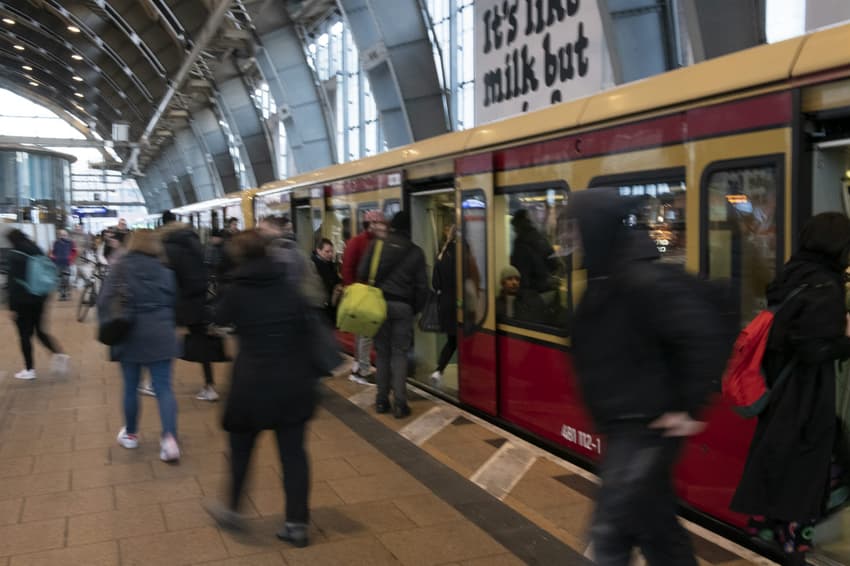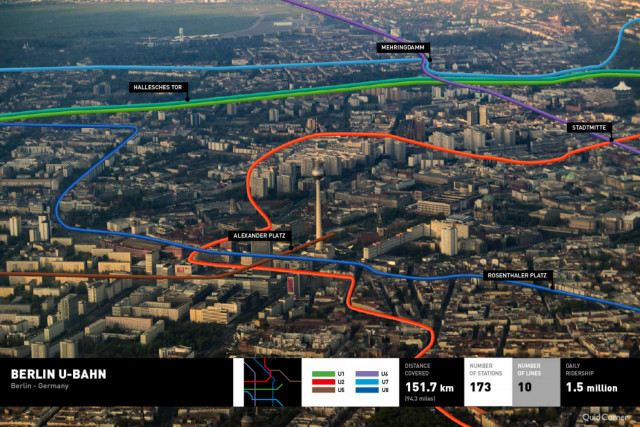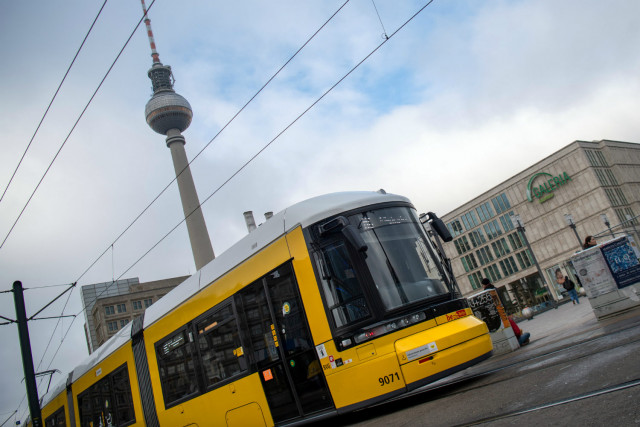'Install AC and reduce ticket costs': How Berlin should improve its public transport

Berlin's buses, trains and trams get the thumbs up but there's lots to be improved on, say readers who shared their views in the first of our series on Germany's public transport.
Germany is looking at ways of improving public transport in a bid to encourage more users to get on board and ditch their cars, which will cut carbon dioxide (CO2) emissions.
But how can they do it?
When we reached out to readers to find out what they think about local public transport in Germany and how it can be improved upon, we were inundated with responses.
From extending the U-Bahn network to building more connections between the airports and the city, this is what respondents to our survey had to say about Berlin and the surrounding area.
In the coming weeks we'll follow up with reports on other parts of the country.
What's good about getting around in Berlin?
With some of the most iconic city train routes in the world - like the U1 which travels between the east and west above ground offering excellent views - Berlin is known for its sprawling network of travel routes.
And as it's one of the best ways to get around for Berliners and tourists visiting in the city, it's always a big talking point.
Recently it hit the news when Berlin mayor Michael Müller said he wanted the city to follow the Austrian capital Vienna's lead and almost halve the cost of its annual public transport tickets to €365.
Lowering the cost of transport is one way that politicians are considering as they try to encourage more people to leave their cars at home and get on the bus.
And, not surprisingly, lots of readers who got in touch with us to share their views on what they love, hate and want to change about local transport in Germany, reducing the cost of tickets was high on the list.
Yet some people, such as Budhaditya Bose, 28, originally from India, commented on the "reasonable" cost of tickets in Berlin.
Lots of people also praised how expansive the transport network is. From the S-Bahn and U-Bahn to buses, trams and regional trains, there are loads of ways to get about the capital.
With its 10 lines and 173 stations, the U-Bahn (underground, subway) runs along a network of about 150 km, making it the fifth largest in Europe.
 An aerial view of Berlin's U-Bahn. Photo: NeoMam Studios
An aerial view of Berlin's U-Bahn. Photo: NeoMam Studios
The S-Bahn covers 15 lines on a 330km long regional network and with almost 170 train stations.
Tram lines extend the route network of the U-Bahn and more than 20 tram lines run through Berlin, mainly in the eastern part of the city
There are also a host of buses serving the city and the outskirts, including night buses. Meanwhile, regional trains also provide connections in the city and to the surrounding state of Brandenburg.
“There are generally a lot of options between the bus, U-Bahn and S-Bahn,” said Arthur, 33, from Ireland.
Mehdi, from Iran, said the infrastructure was good, while Honey Verma, 29, from India also praised the “connectivity and frequency”.
Reese, 40, from the US said there was “great accessiblity and routes” as well as “frequent trains”.
Anwesch Kotta, 29, from India, said; “On the whole Berlin is good when it comes to public transport, but it could be better if there were no strikes and immediate resolution when there are issues.”
Elie, 45, from Israel, said the 24/7 public transport available in Berlin was a huge plus point of living in the city.
Jagdeep Kumar, 31, from India praised the “good connections” and said he was “happy” with what local public transport provider BVG offered.
READ ALSO: Why this German city plans to make public transport free
'Horrible'
However, respondents to our survey also pointed out the not-so-great points. The lack of air conditioning was a big sticking (or sticky...) point for many of the respondents to our survey.
Lakshman, 31, who’s from India, said it made riding public transport in Berlin during summer “horrible”.
He also pointed out that the frequency of buses should be every five to 10 minutes rather than every 20 minutes.
Another reader said drivers "lacked compassion" at times, while one respondent said the S-Bahn system was “unreliable”.
Although alcohol is technically not allowed to be consumed on the transport system, many people do it anyway. One reader said it would be better and make for more pleasant travel experiences if this ban was enforced.
Shreyas, 26, pointed out there was a lack of good connections in eastern Berlin.
Meanwhile, Sudheerkumar, 32, said U-Bahn trains are too noisy, suggesting they could do with some modernization - a suggestion shared by many.
READ ALSO: How riding Germany's public transport really helps you get under a city's skin
 A Berlin tram in central Berlin. Photo: DPA
A Berlin tram in central Berlin. Photo: DPA
Reduce ticket prices
A recent study by the ADAC (General German Automobile Club) comparing the prices of 21 German cities found that the cost of getting around the capital isn't cheap.
Out of the 21 cities they investigated, Berlin came up as the fifth most expensive for a monthly ticket, setting you back €81.
READ ALSO: Revealed - Germany's most expensive (and cheapest) cities for public transport
Weekly tickets are also pricey, costing €30 in Berlin - that's 95 percent more than Munich where it costs €15.40.
Sivasyam, 34, suggested providing the ticket for a "cheaper price that everyone will use it and it can redue air pollution".
Yongshen Deng, 26, agreed and suggested that passengers be charged a "lower cost" for shorter distances.
Asad, 26, also said: "Make tickets cheaper."
What else could be improved when it comes to public transport in Berlin?
Here's a round up of the points our readers thought would make the Berlin public transport experience better:
-
Reduce the cost of tickets
-
Modernize trains and equip them with air conditioning. One reader suggested solar energy AC.
-
Upgrade ticket machines and introduce re-chargable fare cards
-
Transport bosses should plan the types of vehicles being used - for example, bigger buses and longer trains during rush hour.
-
Direct trains connecting Tegel and Schönefeld airports
-
The U-Bahn line seven (U7) should be expanded at Rudow to connect with Schönefeld Airport.
-
Shorter construction/repair breaks which result in replacement buses
-
Improved security
-
Better access for people with disabilities
-
More announcements in English
-
U-Bahn trains should be cleaned more
-
Buses in outskirts of the city should be more frequent and service more areas
Comments
See Also
Germany is looking at ways of improving public transport in a bid to encourage more users to get on board and ditch their cars, which will cut carbon dioxide (CO2) emissions.
But how can they do it?
When we reached out to readers to find out what they think about local public transport in Germany and how it can be improved upon, we were inundated with responses.
From extending the U-Bahn network to building more connections between the airports and the city, this is what respondents to our survey had to say about Berlin and the surrounding area.
In the coming weeks we'll follow up with reports on other parts of the country.
What's good about getting around in Berlin?
Lots of people also praised how expansive the transport network is. From the S-Bahn and U-Bahn to buses, trams and regional trains, there are loads of ways to get about the capital.
With its 10 lines and 173 stations, the U-Bahn (underground, subway) runs along a network of about 150 km, making it the fifth largest in Europe.
 An aerial view of Berlin's U-Bahn. Photo: NeoMam Studios
An aerial view of Berlin's U-Bahn. Photo: NeoMam Studios
The S-Bahn covers 15 lines on a 330km long regional network and with almost 170 train stations.
Tram lines extend the route network of the U-Bahn and more than 20 tram lines run through Berlin, mainly in the eastern part of the city
There are also a host of buses serving the city and the outskirts, including night buses. Meanwhile, regional trains also provide connections in the city and to the surrounding state of Brandenburg.
“There are generally a lot of options between the bus, U-Bahn and S-Bahn,” said Arthur, 33, from Ireland.
Mehdi, from Iran, said the infrastructure was good, while Honey Verma, 29, from India also praised the “connectivity and frequency”.
Reese, 40, from the US said there was “great accessiblity and routes” as well as “frequent trains”.
Anwesch Kotta, 29, from India, said; “On the whole Berlin is good when it comes to public transport, but it could be better if there were no strikes and immediate resolution when there are issues.”
Elie, 45, from Israel, said the 24/7 public transport available in Berlin was a huge plus point of living in the city.
Jagdeep Kumar, 31, from India praised the “good connections” and said he was “happy” with what local public transport provider BVG offered.
READ ALSO: Why this German city plans to make public transport free
'Horrible'
However, respondents to our survey also pointed out the not-so-great points. The lack of air conditioning was a big sticking (or sticky...) point for many of the respondents to our survey.
Lakshman, 31, who’s from India, said it made riding public transport in Berlin during summer “horrible”.
He also pointed out that the frequency of buses should be every five to 10 minutes rather than every 20 minutes.
Another reader said drivers "lacked compassion" at times, while one respondent said the S-Bahn system was “unreliable”.
Although alcohol is technically not allowed to be consumed on the transport system, many people do it anyway. One reader said it would be better and make for more pleasant travel experiences if this ban was enforced.
Shreyas, 26, pointed out there was a lack of good connections in eastern Berlin.
Meanwhile, Sudheerkumar, 32, said U-Bahn trains are too noisy, suggesting they could do with some modernization - a suggestion shared by many.
READ ALSO: How riding Germany's public transport really helps you get under a city's skin
 A Berlin tram in central Berlin. Photo: DPA
A Berlin tram in central Berlin. Photo: DPA
Reduce ticket prices
A recent study by the ADAC (General German Automobile Club) comparing the prices of 21 German cities found that the cost of getting around the capital isn't cheap.
Out of the 21 cities they investigated, Berlin came up as the fifth most expensive for a monthly ticket, setting you back €81.
READ ALSO: Revealed - Germany's most expensive (and cheapest) cities for public transport
Weekly tickets are also pricey, costing €30 in Berlin - that's 95 percent more than Munich where it costs €15.40.
Sivasyam, 34, suggested providing the ticket for a "cheaper price that everyone will use it and it can redue air pollution".
Yongshen Deng, 26, agreed and suggested that passengers be charged a "lower cost" for shorter distances.
Asad, 26, also said: "Make tickets cheaper."
What else could be improved when it comes to public transport in Berlin?
Here's a round up of the points our readers thought would make the Berlin public transport experience better:
-
Reduce the cost of tickets
-
Modernize trains and equip them with air conditioning. One reader suggested solar energy AC.
-
Upgrade ticket machines and introduce re-chargable fare cards
-
Transport bosses should plan the types of vehicles being used - for example, bigger buses and longer trains during rush hour.
-
Direct trains connecting Tegel and Schönefeld airports
-
The U-Bahn line seven (U7) should be expanded at Rudow to connect with Schönefeld Airport.
-
Shorter construction/repair breaks which result in replacement buses
-
Improved security
-
Better access for people with disabilities
-
More announcements in English
-
U-Bahn trains should be cleaned more
-
Buses in outskirts of the city should be more frequent and service more areas
Join the conversation in our comments section below. Share your own views and experience and if you have a question or suggestion for our journalists then email us at [email protected].
Please keep comments civil, constructive and on topic – and make sure to read our terms of use before getting involved.
Please log in here to leave a comment.